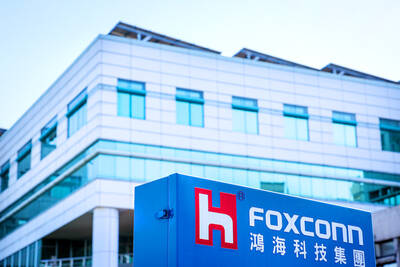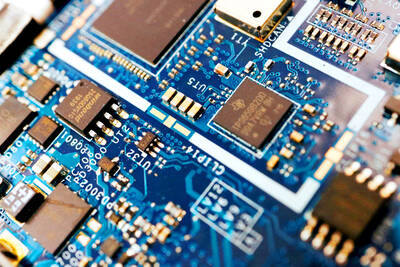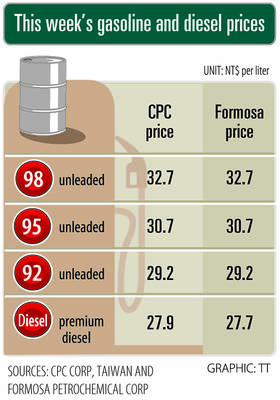Industrial production fell 5.65 percent year-on-year last month as weak demand dampened the recovery following the Lunar New Year holiday, the Ministry of Economic Affairs said yesterday.
Last month’s data marked the ninth consecutive month of annual declines, the ministry said.
The government’s industrial production gauge for the nation’s main industries saw an across-the-board annual decline last month for manufacturing, mining and quarrying, electricity and gas supply, and water supply.
The sole exception was architectural engineering, as companies tend to initiate projects ahead of the Lunar New Year holiday.
The manufacturing sector — which accounts for more than 90 percent of industrial output — fell 6.32 percent year-on-year and 3.67 percent month-on-month.
In particular, the electronic components industry, which is the backbone of the nation’s manufacturing sector, saw an annual decline of 7.46 percent as tepid consumer electronics sales crimped inventory orders for ICs, printed circuit boards, display panels and glass substrates.
The semiconductor industry felt the brunt of the downturn last month, with output declining 10.52 percent year-on-year from the high basis set last year, the ministry said.
Production in the computer industry dipped 7.77 percent from the previous year due to soft demand for handheld devices, tablets, notebooks and semiconductor testing equipment, offsetting gains in output for smartwatches and computer components.
Industrial production is not expected to recover significantly until May, Department of Statistics Deputy Director-General Yang Kuei-hsien (楊貴顯) told a news conference in Taipei.
“The slump will likely persist this month, due to the lull during the Lunar New Year holiday,” Yang said, adding that the Feb. 6 earthquake is estimated to dampened technology-sector output in the south by between 5 percent and 7 percent.
Meanwhile, the inventory-to-sales ratio for the manufacturing sector improved to 72.86 percent from 74.35 percent in December last year, with the figure for the electronic components industry improving to 52.34 percent from 57.2 percent.
“Although these figures indicate a period of inventory digestion in the electronics sector might be approaching its end, they do not signal a recovery in overall economic growth momentum,” Yang said.
“Companies often adjust their inventory levels in response to softening global economic growth,” Yang said, adding that a recovery would need a significant rise in sales and demand.
“Inventory levels among businesses will continue to fluctuate, but at a narrower band than previous economic downturns,” he said.
Yang said that the few bright spots are the steel and machine tools industries, where prices have began stabilizing and companies have been reporting better visibility of upcoming order volumes.
In a separate release, the ministry said that domestic commercial sales — which include the food and beverage, retail and wholesale sectors — last month fell 6.1 percent year-on-year to NT$806 billion (US$24.07 billion).
Despite a setback in wholesale sector, retail sales gained 6.9 percent year-on-year to NT$362.7 billion, a new monthly high, while restaurant sales gained 7.5 percent year-on-year to NT$37.6 billion, data showed.

Hon Hai Precision Industry Co (鴻海精密) yesterday said that its research institute has launched its first advanced artificial intelligence (AI) large language model (LLM) using traditional Chinese, with technology assistance from Nvidia Corp. Hon Hai, also known as Foxconn Technology Group (富士康科技集團), said the LLM, FoxBrain, is expected to improve its data analysis capabilities for smart manufacturing, and electric vehicle and smart city development. An LLM is a type of AI trained on vast amounts of text data and uses deep learning techniques, particularly neural networks, to process and generate language. They are essential for building and improving AI-powered servers. Nvidia provided assistance

DOMESTIC SUPPLY: The probe comes as Donald Trump has called for the repeal of the US$52.7 billion CHIPS and Science Act, which the US Congress passed in 2022 The Office of the US Trade Representative is to hold a hearing tomorrow into older Chinese-made “legacy” semiconductors that could heap more US tariffs on chips from China that power everyday goods from cars to washing machines to telecoms equipment. The probe, which began during former US president Joe Biden’s tenure in December last year, aims to protect US and other semiconductor producers from China’s massive state-driven buildup of domestic chip supply. A 50 percent US tariff on Chinese semiconductors began on Jan. 1. Legacy chips use older manufacturing processes introduced more than a decade ago and are often far simpler than

STILL HOPEFUL: Delayed payment of NT$5.35 billion from an Indian server client sent its earnings plunging last year, but the firm expects a gradual pickup ahead Asustek Computer Inc (華碩), the world’s No. 5 PC vendor, yesterday reported an 87 percent slump in net profit for last year, dragged by a massive overdue payment from an Indian cloud service provider. The Indian customer has delayed payment totaling NT$5.35 billion (US$162.7 million), Asustek chief financial officer Nick Wu (吳長榮) told an online earnings conference. Asustek shipped servers to India between April and June last year. The customer told Asustek that it is launching multiple fundraising projects and expected to repay the debt in the short term, Wu said. The Indian customer accounted for less than 10 percent to Asustek’s

Gasoline and diesel prices this week are to decrease NT$0.5 and NT$1 per liter respectively as international crude prices continued to fall last week, CPC Corp, Taiwan (CPC, 台灣中油) and Formosa Petrochemical Corp (台塑石化) said yesterday. Effective today, gasoline prices at CPC and Formosa stations are to decrease to NT$29.2, NT$30.7 and NT$32.7 per liter for 92, 95 and 98-octane unleaded gasoline respectively, while premium diesel is to cost NT$27.9 per liter at CPC stations and NT$27.7 at Formosa pumps, the companies said in separate statements. Global crude oil prices dropped last week after the eight OPEC+ members said they would